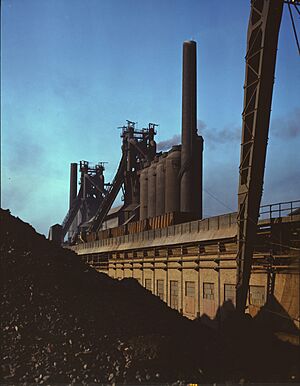Carnegie Steel Company facts for kids
| Partnership | |
| Industry | Steel, coke, railroad |
| Successor | U.S. Steel |
| Founded | July 1, 1892 |
| Founders | Andrew Carnegie Henry Clay Frick George Lauder Henry Phipps Jr. |
| Defunct | March 2, 1901 |
| Headquarters | Pittsburgh, Pennsylvania |
| Products |
|
| Services | Manufacturing |
The Carnegie Steel Company was a huge company that made steel in the late 1800s. It was started by Andrew Carnegie and his friends in Pittsburgh, Pennsylvania. They brought together many steel factories in the area.
The company began in 1892. Later, in 1901, it was sold in a very big deal. It became a main part of a new company called U.S. Steel. This sale made Andrew Carnegie one of the wealthiest people ever!
Contents
How Carnegie Steel Started
Andrew Carnegie began building his first steel factory in 1872. It was called the Edgar Thomson Steel Works. This factory was in Braddock, Pennsylvania.
The Thomson Steel Works started making railroad tracks in 1874. They made steel cheaply by paying workers lower wages. They also used very good technology and smart ways to organize the work. This helped them sell steel for a lot of money.
The demand for steel was growing fast as industries developed. Carnegie himself believed they made a 40% profit on their investments. This means if they put in $100,000, they made $40,000 in profit!
The Edgar Thomson Steel Works made so much money that Carnegie and his partners bought other steel factories nearby. His partners included Henry Clay Frick, his cousin George Lauder, and Henry Phipps Jr..
One important factory they bought was the Homestead Steel Works in 1883. The Allegheny, Monongahela, and Ohio rivers were very helpful. They allowed heavy materials for steelmaking to be transported easily. All the factories were built close to these rivers.
Henry Clay Frick suggested that all the different factories and businesses should be combined. Carnegie agreed. So, on July 1, 1892, they formed the Carnegie Steel Company.
How Carnegie Steel Operated
The main office for Carnegie Steel was in the Carnegie Building in Downtown Pittsburgh. This building was one of the first skyscrapers. It was built to show off how steel could be used in construction. The building was fifteen stories tall. It was left uncovered for a whole year so people could see its steel frame. The Carnegie Building was later taken down in 1952.
Carnegie Steel made big improvements in how they made steel in the 1880s. They installed a new system called the open hearth furnace at the Homestead factory in 1886. This made it possible to create steel strong enough for building structures.
They also made special armor plates for the U.S. Navy and other countries' armies. These special products were sold for much higher prices. The factories also started using a continuous production system. This meant things moved from one step to the next without stopping.
Carnegie added much better ways to move materials around. This included overhead cranes, hoists, and charging machines. All these tools made steelmaking much faster. They also allowed the company to produce huge amounts of steel.
As the factories grew, many more workers were hired, especially those with fewer skills. In 1892, some skilled workers went on strike at Homestead. They wanted shorter work hours and no pay cuts. The strike was not successful. After this, the company kept growing. Its profits increased every year, reaching $21 million in 1899.
J&L Steel was a major competitor to Carnegie Steel in the Pittsburgh area.
Carnegie Steel Factories
Carnegie Steel had many different factories and operations. Here are some of them:
- Carnegie Carrie Furnaces in Rankin: This was a steel mill with five blast furnaces.
- Duquesne works in Cochran: Another steel mill with four blast furnaces.
- Edgar Thomson works in Braddock: A large steel mill with eleven blast furnaces.
- Homestead works in Munhall: A major steel mill.
- Lucy furnaces in Pittsburgh: A steel mill with two blast furnaces.
- Monessen works in Monessen: A rolling mill and steel works.
The Sale of Carnegie Steel
In 1901, the Carnegie Steel Company was sold to U.S. Steel. This new company was created by J. P. Morgan. The sale was for about $492 million. Andrew Carnegie himself received $226 million from the sale. This made him one of the richest people in history.
U.S. Steel was a very large company that included many smaller companies. The name of the Carnegie Steel part was later changed to the Carnegie-Illinois Steel Company in 1936.
See also
- History of the steel industry (1850–1970)
- Illinois Steel Company


